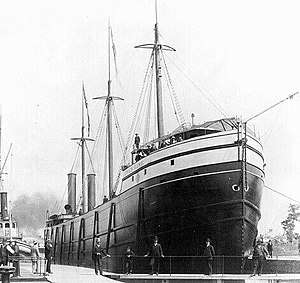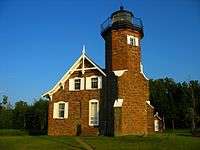SS Ira H. Owen
The SS Ira H. Owen was a Great Lakes freighter that sank near Outer Island in the Apostle Islands, Lake Superior, in the Mataafa Storm on 28 November 1905. She was loaded with 116,000 bushels of barley which was considered a "light load". The Owen's sinking took the lives of 19 men.[1][2] The remains of the Owen have never been found, but some people claim she reappears as a ghost ship.[3]
 The Ira H. Owen prior to the Mataafa Storm of 1905 | |
| History | |
|---|---|
| Name: | Ira H. Owen |
| Operator: |
|
| Port of registry: |
|
| Builder: | Globe Iron Works Company |
| Yard number: | 14 |
| Launched: | July 7, 1887 |
| Completed: | 1887 |
| In service: | 1887 |
| Out of service: | 1905 |
| Identification: | U.S. Registry #100410 |
| Fate: | Wrecked in the Mataafa Storm on 28 November 1905 |
| Status: | Missing |
| General characteristics | |
| Class and type: | Bulk Freighter |
| Tonnage: |
|
| Length: | 278.3 ft (84.8 m) |
| Beam: | 39 ft (12 m) |
| Depth: | 19 ft (5.8 m) |
| Propulsion: | Triple expansion steam engine |
| Crew: | 19 |
| Notes: | The Owen was one of the first steel-hulled Great Lakes freighters |
History
The Ira H. Owen was a product of the Globe Iron Works Company of Cleveland, Ohio. She was launched on July 7, 1887 as hull #14 and entered service on July 28, 1887. She was one of the first steel-hulled Great Lakes freighter to sail on the lakes. She had a length of 278.3 feet, a beam of 39 feet and a height of 19 feet.[4] She had a gross tonnage of 1753.22 tons and a net tonnage of 1497.77 tons.[5] She also had two smokestacks.
On November 29, the Owen ran aground near the Soo Locks.[6] In June 1892, the Owen collided with the two-masted schooner Belle Brown in a heavy fog about sixteen miles off Ludington, Michigan. On 20 July 1897, the Owen collided with the steamer Susquehanna in heavy fog off Presque Isle Point, Lake Huron. Both the Owen and the Susquehanna sustained damage, $10,000 damage for Owen.[7] In December 1903, the Owen suffered a fire in her boiler room. She was bound from Manitowoc, Wisconsin to Buffalo, New York with a load of grain at the time the fire occurred. She was later towed to Sturgeon Bay for repairs by the tugboats Ann Arbor No. 1, George Burnham and the Hyacinth. In October 1904, the Owen was fully loaded with coal when she collided with the Henry W. Oliver in the St. Marys River.
Final voyage
Author James M. Keller wrote about the final voyage of the Owen in his book The "Unholy Apostles":
On the morning of November 28, 1905 the Ira H. Owen left Duluth downbound with a load of barley. The weather was worsening as she passed the Apostles, but Captain Hulligan decided against seeking shelter at this point. As she was steaming by outer Island the furious gale picked up and started pounding the Owen mercilessly. Enormous seas swelled, temperatures dropped below zero, hurricane force winds whipped the driven snow -- and the Ira H. Owen found herself in open water with no place of refuge in sight. Desperately the brave crew fought the wild seas as best they could. At the height of the terrible storm Captain Alva Keller of the steamer Harold B. Nye spotted the Owen. She appeared to be in dire straits and was constantly blowing distress signals, but the 380 foot Nye was in so much trouble herself that she couldn't possibly lend assistance. The dense snow squall then descended upon the Owen, completely blocking her from Keller's view. The Nye continued to ride out the monstrous waves for two hours when slowly, the squall lifted and faint visibility was restored. Keller immediately grabbed his binoculars and pointed them in the direction where he last sighted the Owen. Anxiously, tensely, he scanned the water, but saw nothing. The Ira H. Owen had vanished.[8][9]
Victims
| Name | Rank | Notes |
|---|---|---|
| Joseph Hulligan | Captain | Captain Joseph Hulligan had taken ill before her final voyage, and had to be temporarily replaced by a fill-in.[10] |
| Thomas Honner | First Mate | As the ranking officer after Captain Hulligan, First Mate Thomas Honner had to temporarily fill in for him.[10] |
| M. Haggerty | Second Mate[10] | |
| H. Buchanan | Engineer[10] | |
| J.P. Alger | Second Engineer[10] | |
| J. Jacobson | Wheelsman[10] | |
| L. Montray | Wheelsman[10] | |
| C. McKay | Lookout[10] | |
| J. Knudson | Lookout[10] | |
| Oliver Campbell | Deckhand[10] | |
| N. Hook | Oiler[10] | |
| 8 other unidentified men | Unknown | The names of these 8 men were never reported.[10] |
Today
Although her wreck has not been located, according to the Wisconsin Historical Society the wreck of the Owen most likely lies in deep water off Outer Island in the Apostles.[11]
References
- "Owen, Ira H." Great Lakes Vessel History. Retrieved 11 January 2018.
- "Mixstory 1905". Ric Mixter. Retrieved May 6, 2020.
- "The Mataafa Blow: The Stormy Horror of 1905". Lake Superior Magazine. Retrieved 23 April 2018.
- "Owen, Ira H." Bowling Green State University. Retrieved 15 February 2018.
- "Ira H. Owen (1887)". Wisconsin Shipwrecks. Retrieved 11 January 2018.
- "Owen, Ira H.; 1887; Bulk Freighter; US100410". Great Lakes Maritime Database. Retrieved 15 February 2018.
- "Annual report of the Supervising Inspector-general Steamboat-inspection Service, Year ending June 30, 1898". Washington: Government Printing Office. 1898. p. 67. Retrieved 7 April 2020 – via Haithi Trust.
- Keller, James M. The Unholy Apostles. ISBN 0-933577-001.
- "Ira H. Owen (Propeller)". Maritime History of the Great Lakes. Retrieved 15 February 2018.
- Brown, Curt (2011). So Terrible a Storm: A Tale of Fury on Lake Superior. Voyageur Press. pp. 309–310. ISBN 978-0760340127.
- "Wisconsin's Historic Shipwrecks-An Overview and Analysis of Locations for a State/Federal Partnership with the National Marine Sanctuary Program" (PDF). Wisconsin Historical Society. Retrieved 21 May 2018.
| Wikimedia Commons has media related to Ira H. Owen (ship, 1887). |
